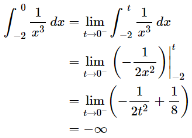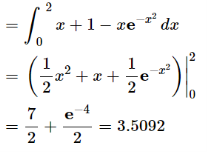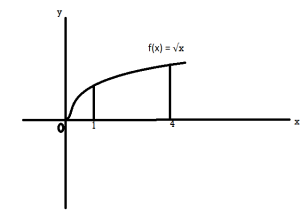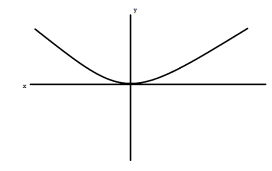UNIT 1
Question 1-: Evaluate

Solution:
Let
 …
… 
 By L – Hospital rule,
By L – Hospital rule,



Question-2: Evaluate 
Solution:
Let
 …
… 
 By L – Hospital rule
By L – Hospital rule
 …
… 
 …
… 




Question-3: Find the value of a, b if 
Solution:
Let
 …
… 
 By L – Hospital rule
By L – Hospital rule
 …
… 
 …
… 
 … (1)
… (1)
 …
… 


But 


 From equation (1)
From equation (1)



Question-4: Evaluate 
Solution:
Let
 …
… 
 Taking log on both sides,
Taking log on both sides,

 …
… 
 By L – Hospital rule,
By L – Hospital rule,


i.e. 


Question-5: find out the integral  is convergent or divergent. Find the value in case of convergent.
is convergent or divergent. Find the value in case of convergent.
Sol. Here we will convert the integral into limit ,
 =
= 
= 
= 
= ∞
As we can see , here limit does not exist. i.e. that is infinity.
So we can say that the given integral is divergent.
Question-6: find out the integral  is convergent or divergent. Find the value in case of convergent.
is convergent or divergent. Find the value in case of convergent.
Sol. Covert to the limit ,
 =
= 
= 
= 
Again the limit does not exist that means the integral is divergent
Question-7: find out the integral  is convergent or divergent. Find the value in case of convergent.
is convergent or divergent. Find the value in case of convergent.
Sol. As we see, the given is integrand is not continuous at x = 0 , we will split the integral,
 =
=  +
+ 
We will check one by one whether the integrals are convergent or divergent,

As we found that, integral is divergent
We don’t need to check for the second one.
Question-8: Find γ(-½)
Solution: (-½) + 1 = ½
γ(-1/2) = γ(-½ + 1) / (-½)
= - 2 γ(1/2 )
= - 2 π
Question-9: . Show that 

Solution : =
= 

= 


= 


 ) .......................
) .......................
= 

= 


Question-10: ): Evaluate I = 
Solution:







= 2 π/3
Question-11: Evaluate
Solution :Let
Put  or
or  ,
,
 ,
,
When ,
, ;
; ,
,
 | o |  |
 | 1 | 0 |
Also












Question- 12: find the area under the curves where y = x and y = x + 1, x = 2 and y-axis.
and y = x + 1, x = 2 and y-axis.
Sol. When we draw the graph, curve does not meet, but depend on two vertical lines,
Here boundary is [0 , 2]
Area under the curve,
A = 

So that the area under the curve is 3.2092 unit square.
Question-13: find the average value of the function f(x) = x³ over the interval[0,1].
Sol. We know that
f( avg.) = 
=  =
=  = 1 / 4
= 1 / 4
Question-14: A force of 1200 N compresses a spring from its natural length of 18 cm to a length of 16 cm. How much work is done in compressing it from 16 cm to 14 cm?
Sol. Here,
F = kx
So that,
1200 = 2k
K = 600 N/cm
In that case,
F = 600x
We know that,
W = 
W =  , which gives
, which gives
W = 3600 N.cm
Question-15: Find the volume of the solid of revolution generated by rotating the region between the graph of f(x) = √x over the interval [1,4] around x-axis.
Sol. The graph of the function will look like as follow,

On rotation it will make circle ( cross-section)
We know that,
V = 
=  =
=  , which gives
, which gives
= 
The volume is 
Question-16: suppose a wire hanging on two poles follows the curve,
f(x) = a cosh(x/a)
Find the length of the wire.
Sol. We will find the first derivative of f(x),
f’(x) = sinh(x/a)
The curve of f(x) will look like,

Hence the curve os symmetric, we will measure the length of one side first,
The limits on one side will be, 0 to b
We know that
Length of Arc = 
Put f’(x) = sinh(x/a), we get
Length of Arc = 
Use the identity,

= 
= 
We get on solving,
a sinh(b/a)
On both sides, the length of the curve will be,
2 a sinh(b/a)